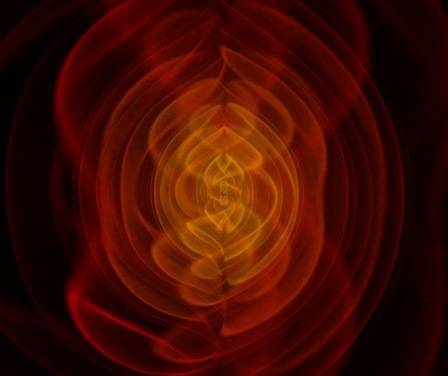University scientists win gravitational waves prize
Published: 4 May 2016
Just months after being involved in one of the biggest sceintific breakthroughs of the decade, University of Glasgow scientists involved in the Gravitational Waves discovery have won a share of a top international prize.
Just months after being involved in one of the biggest scientific breakthroughs of the decade, University of Glasgow scientists involved in the Gravitational Waves discovery have won a share of a top international prize.
Simulation of gravitational wave emission from merging black holes (NASA/C. Henze)
A third of the $3m (£2.04m) Yuri Milner Breakthrough Prize Foundation in Fundamental Physics will be shared among three of the founders of the ‘LIGO’ gravitational waves observatory with the remainder shared among the team of scientists involved in the research.
The founders of the Laser Interferometer Gravitational-Wave Observatory (LIGO) group - which included Kip Thorne (Emeritus Caltech); Rainer Weiss (Emeritus MIT); and Professor Ronald Drever (Emeritus Caltech, formerly of Glasgow) - will share $1m equally between them.
The remaining $2m (£1.35m) will be shared equally among the 1,012 other researchers and engineers globally who worked on the LIGO team or contributed to the research, including scientists from the University of Glasgow’s Institute for Gravitational Research. Each receives about $2000 (£1350).
The prestigious prizes will be awarded at a formal ceremony later this year.
The award is in recognition of the monumental scientific breakthrough which finally confirmed once and for all one of the last great predictions of Albert Einstein's 1915 general theory of relativity.
Scientists, including those here at Glasgow, helped create the technology to observe ripples in the fabric of space time called gravitational waves, arriving at the earth from a cataclysmic event in the distant universe, opening an unprecedented new window onto the cosmos. To many University of Glasgow scientists it had been a life-long quest.
Reacting to theannouncement, Professor Sheila Rowan, Director of the Institute for Gravitational Research at the University of Glasgow, said: "I'm absolutely delighted that the 2016 Special Breakthrough Prize in Fundamental Physics has been awarded for the observation of gravitational waves, and in particular that the committee chose specifically to share part of the prize amongst all the scientists and engineers who contributed to the discovery - the success of the field is built on the contributions of many people and it's terrific to see the whole LIGO team recognised."
Gravitational waves carry information about their dramatic origins and about the nature of gravity. Physicists concluded that the detected gravitational waves were produced during the final fraction of a second of the merger of two black holes to produce a single, more massive spinning black hole. This collision of two black holes had been predicted but never observed.
University of Glasgow researchers had been working for decades to support the worldwide effort to detect gravitational waves, under efforts led originally by Professor Ron Drever before his move to Caltech in the late 1970's, followed by Professor Jim Hough who became the first Director of the Institute for Gravitational Research in Glasgow.
Today’s scientists from the University's Institute for Gravitational Research led on the development of the sensitive mirror suspensions in the heart of the LIGO detectors in Livingston and Hanford – the detectors responsible for the first detection. The mirror suspension technology, developed in partnership with the University of Birmingham, the University of Strathclyde, and the STFC Rutherford Appleton Laboratory, was based on Glasgow's pioneering work for UK/German GEO600 detector.
Now the work of all those involved in this global scientific breakthrough is being rewarded.
For further information contact Jane Chilton, communications officer 0141 3303535 / jane.chilton@glasgow.ac.uk
First published: 4 May 2016
<< May
Related links

